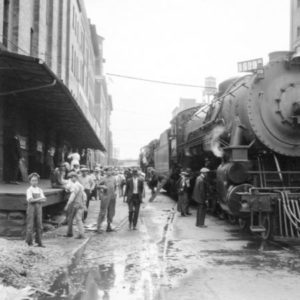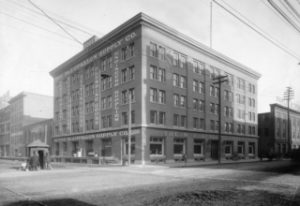HISTORY

The six-story, 36,000-square-foot brick building was erected in 1908 as a warehouse for the Kennicott-Patterson Transfer and Storage Company.

Merchant Transfer and Storage Company used the building as a warehouse for dry goods arriving or departing by train at Union Station.
The building was owned by Gates Rubber Company as a warehouse. For a time, it leased space to Morey Mercantile (bulging at the seams next door). The Mercantile was the largest grocery business in the west in terms of sales, territory and number of employees under the brand name Solitaire.
Following World War II, the lower downtown area went through a slow, steady decline. The number of passenger trains passing through dropped from 80 to two per day. The building sat vacant temporarily before being remodeled into office space.
The building was purchased by Joyce Meskis, the owner of the Tattered Cover Bookstore, a Denver institution. From this warehouse location and the building next door, the Tattered Cover shipped, received and warehoused their stock of books. The building was also home to the first official offices of the Wynkoop Brewing Company, owned by John Hickenlooper.
In 1997, John Powers (board member for the Colorado Environmental Coalition) worked with John Hickenlooper to allow the Colorado Environmental Coalition (now Conservation Colorado, The Alliance Center’s first tenant) to move into the historic warehouse in Lower Downtown Denver. During the next seven years, Powers negotiated for eight more nonprofit organizations to move in.
In 2004, John Powers, a longtime board member of the Colorado Environmental Coalition, and Janna Six co-founded the nonprofit Alliance for Sustainable Colorado (now The Alliance for Collective Action) and purchased the building (now The Alliance Center) from Tattered Cover. The vision was to create a physical hub where local public-interest groups could pool resources on projects. It would provide an incubator for collaboration offering traditionally tight-budgeted nonprofits an opportunity to share ideas with like-minded advocacy groups and reduce expenses.
Within the first few months of opening in 2004, The Alliance Center provided office and meeting space for the successful statewide citizens’ ballot initiative, which was the first voter-approved renewable energy portfolio standard in the US. The initiative required 10 percent of electricity from investor owned utilities be generated from renewable energy by 2020.
Staff and partners created the Better Building Coalition to press the Colorado legislature to set high performance standards for publicly owned buildings.
The Center received the Energy Champion Award from Colorado Governor Owens’ Office of Energy Management and Conservation for our performance and efforts.
For the first year of The Alliance’s ownership, the building underwent significant construction to convert the warehouse into office spaces, making liberal use of eco-friendly green building construction with high-tech concepts. The Alliance became the second building in the world to earn two US Green Building Council LEED (Leadership in Energy and Environmental Design) certifications—Existing Buildings Gold and Commercial Interiors Silver—while also earning U.S. EPA Energy Star Leader status.
The leadership awards celebrate the individuals and groups at the forefront of sustainability in the built environment. We received this for our on-site educational signage and tours covering key sustainability issues and green building solutions.
These awards honor projects throughout the city for excellence in architecture, exterior design and place-making. The Alliance Center received it for our efforts using and promoting green building practices.
Envisioned by John Powers, Michael Huttner (founder of ProgressNow), Markos Moulitsas (founder of Daily Kos) and Alliance staff, and located in The Alliance Center’s parking lot, the Big Tent was a nonprofit, nonpartisan event that provided dedicated space for new media journalists and bloggers during the 2008 Democratic National Convention. The Big Tent included the use of both The Alliance Center—one of Colorado’s greenest buildings—as well as an 8,000-square-foot, two-story temporary structure that housed a state-of-the-art blogging/new media lounge, the Google retreat and the Digg Stage (the main stage on the first floor). The Big Tent hosted a diverse range of participants from local tweeters to national media figures such as Rachael Maddow and Dan Rather.
Awarded by the Colorado Department of Public Health and Environment to companies that voluntarily go beyond regulatory compliance to reduce their impact on the environment. The Alliance Center has maintained our Gold Leader status (the highest designation) since 2008.
Founder John Powers received the The Wirth Chair Pioneer of the New Energy Economy Award.
The Alliance Center received an award as One of the Best Bets for Going Green.
The Alliance Center achieved a LEED Gold recertification.
The Alliance Center’s renovation was chosen by the City of Denver to serve as its showcase project for the Department of Energy’s Better Buildings Challenge, which is a federal initiative to make buildings 20 percent more energy efficient over the next decade. Click here to read about our project and how we decreased our per capita energy usage by over 49 percent.
The Center was the first building in Colorado to obtain Platinum certification in any of LEED’s newest, and more stringent, v4 categories.
The Center achieved the WELL Health-Safety Rating for our commitment to occupant wellness.
Before its revitalization, The Center's garden had fallen into disrepair. Previous plants had not survived in the space due to poor soil health and unsustainable watering needs. The selection of plants was not suitable for the sunken patio’s microclimate. Visitors will now find a diverse and colorful pollinator garden right in the heart of downtown Denver. The Green Waves Garden serves as a space to inspire solutions, foster engagement and allow visitors, tenants and members of the public to cross pollinate. It is a restorative amenity, both to the humans and pollinators who use it.


